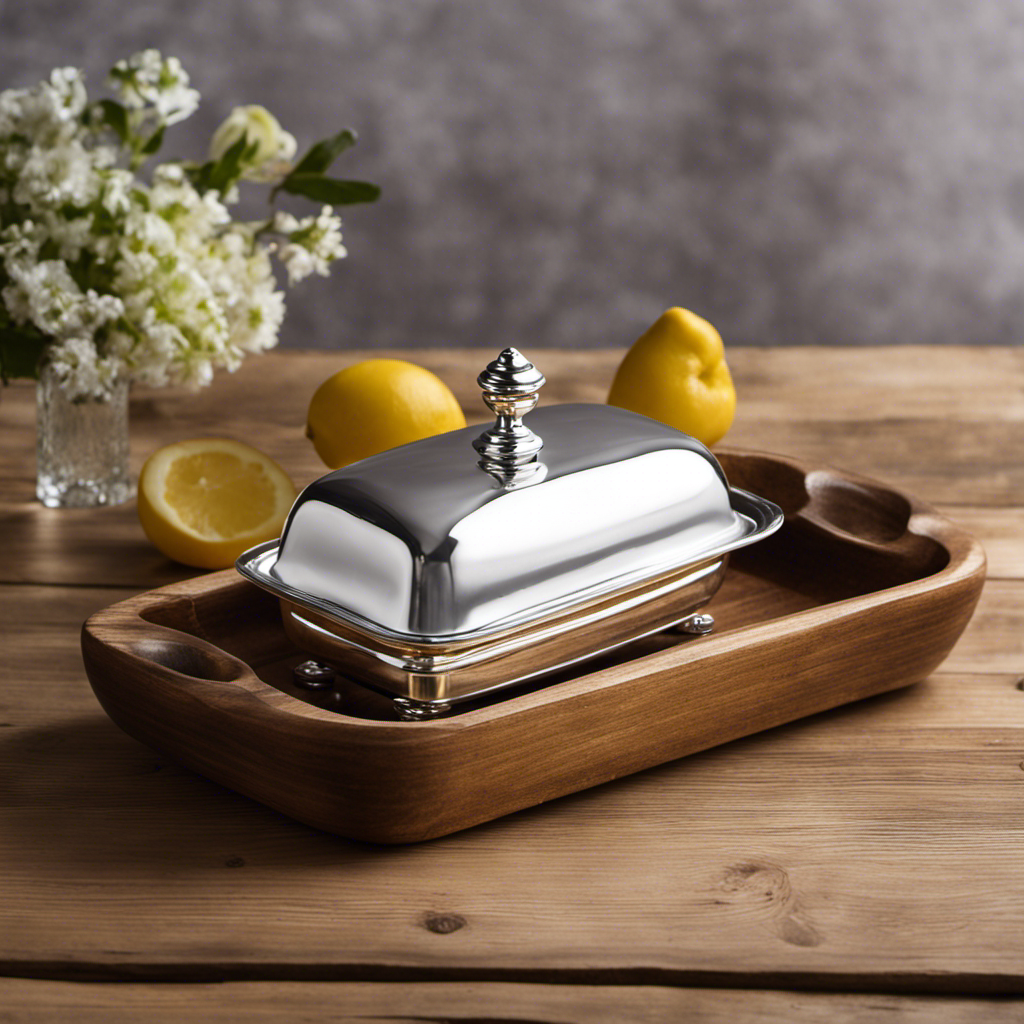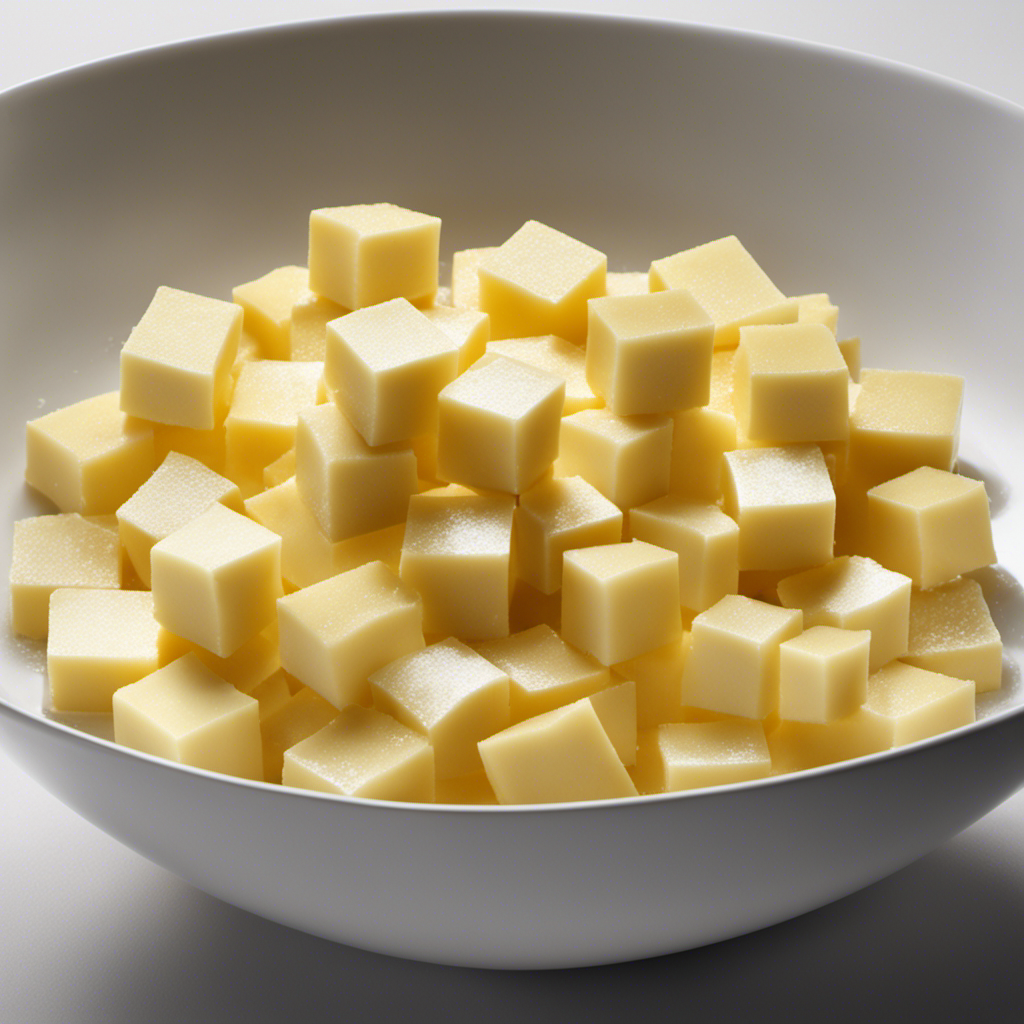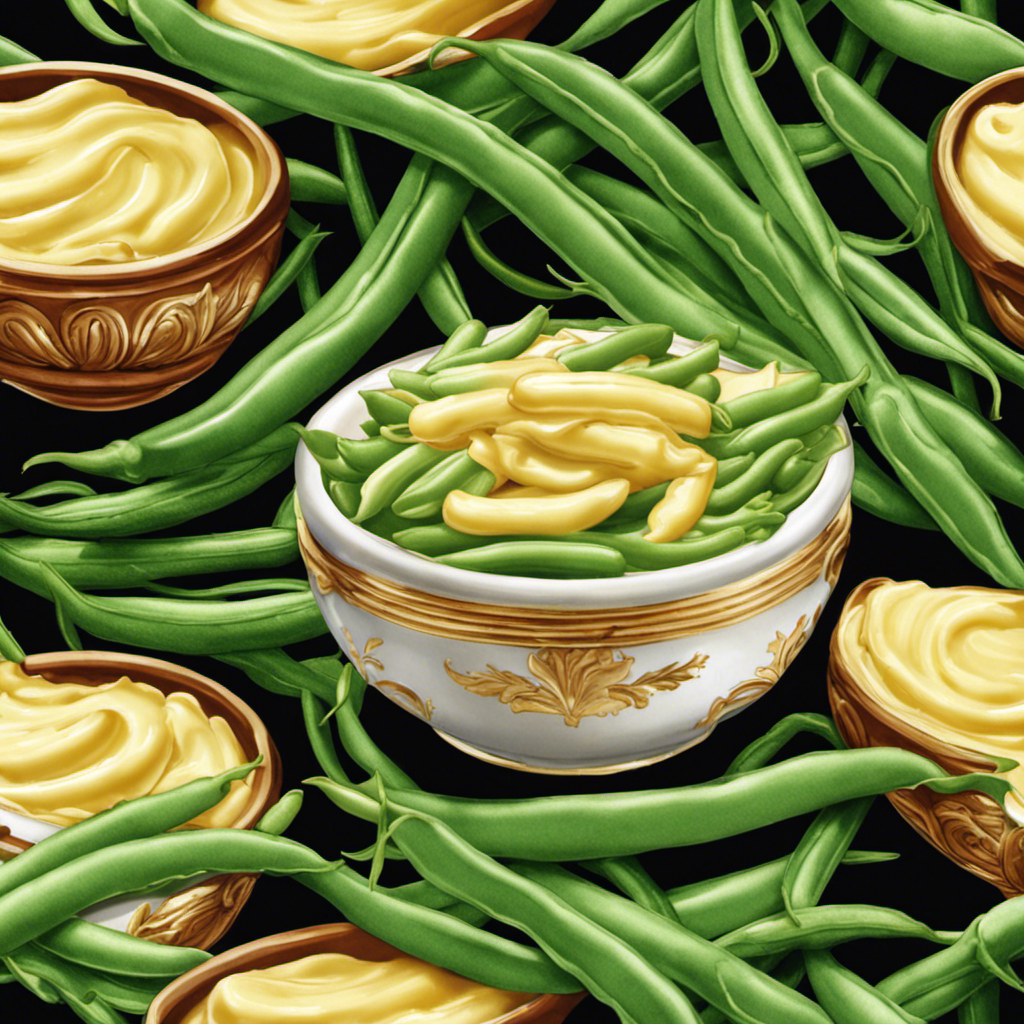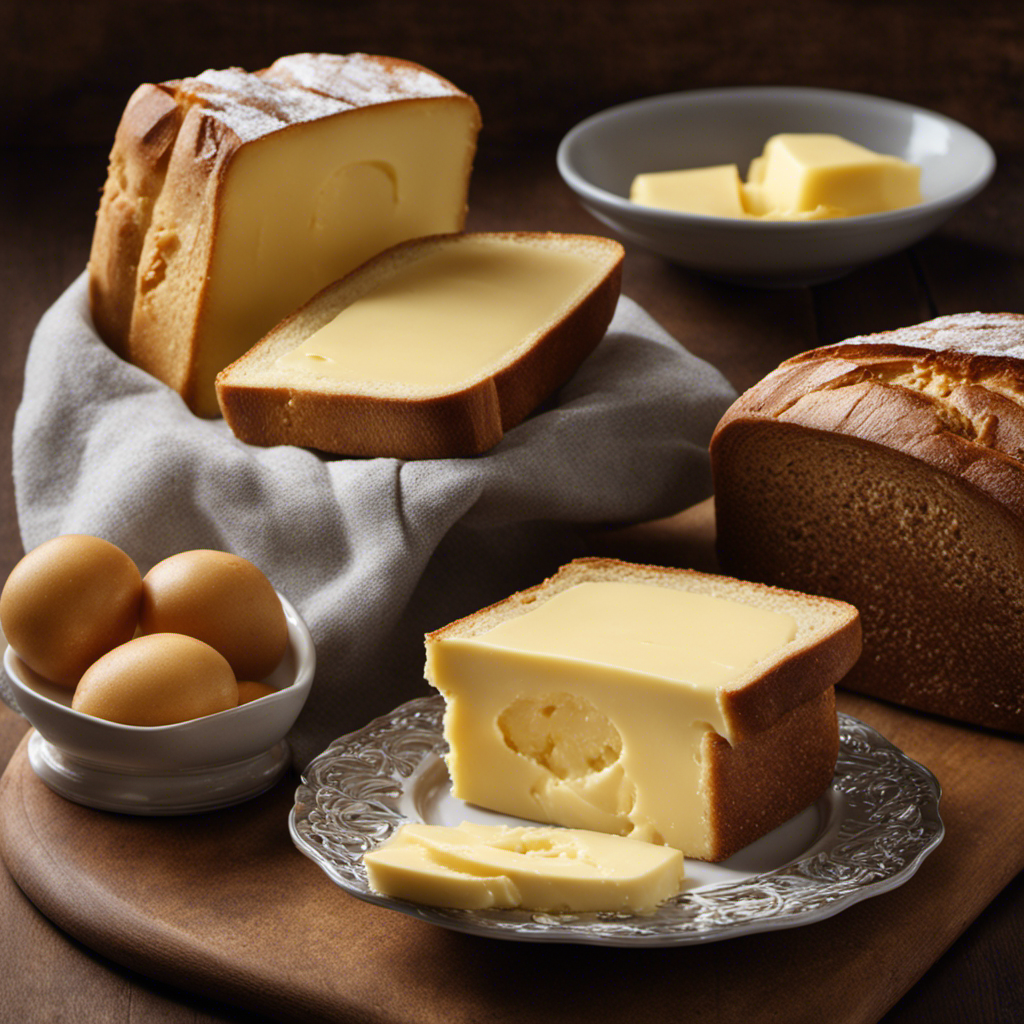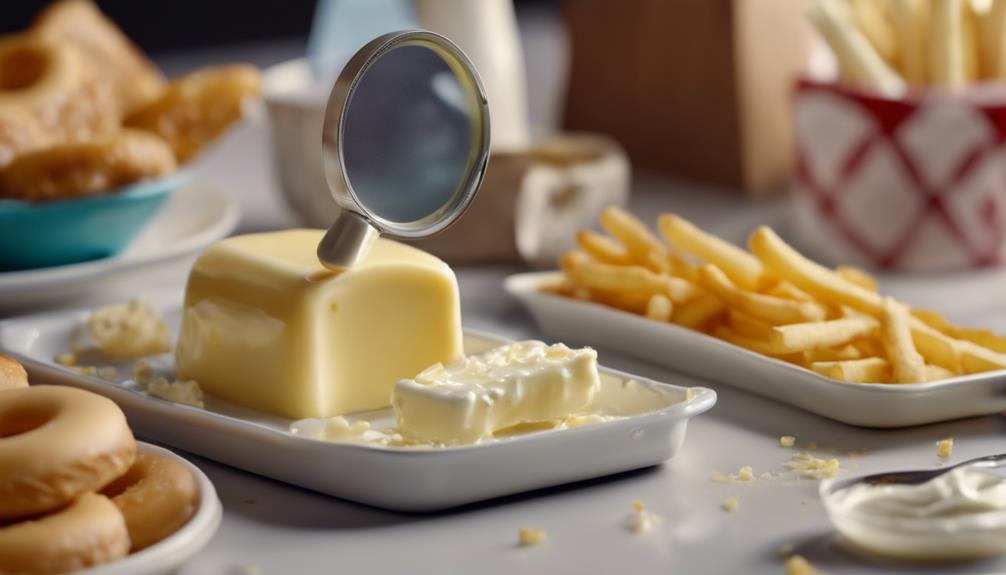I adore the deep, nutty taste that browned butter adds to my dishes, hence you can understand my irritation when my butter simply refused to behave as expected.
As I delved into the science behind browning butter, I discovered common mistakes that prevent this magical transformation. Through trial and error, I uncovered the factors that affect butter browning and learned some tips and tricks to achieve perfectly browned butter every time.
Join me on this journey as we unravel the mysteries of why your butter may not be browning and find solutions to this culinary conundrum.
Key Takeaways
- Heating butter initiates the Maillard reaction, resulting in a nutty aroma and rich flavor.
- Common mistakes that prevent butter browning include incorrect temperature control, insufficient butter quantity, using salted butter, and inadequate stirring.
- Factors that affect butter browning include heat and timing, the quality of butter, freshness, storage, and different pan types.
- Tips and tricks for perfectly browned butter include using a lower heat setting, using unsalted butter with higher milk solids content, clarifying the butter, and experimenting with alternative methods such as the microwave or oven method.
The Science of Browning Butter
The science behind browning butter is fascinating. When you heat butter, the milk solids in it start to undergo the Maillard reaction, a chemical reaction that occurs between amino acids and reducing sugars. This reaction produces a complex array of new compounds, giving the butter a nutty aroma and rich flavor.
To brown butter effectively, there are a few techniques you can use. First, start with unsalted butter to have more control over the salt content. Next, melt the butter over medium heat and continue cooking until the milk solids turn golden brown. It is important to stir the butter constantly to ensure even browning and prevent burning.
Lastly, once the desired color and aroma are achieved, remove the butter from the heat to prevent further browning. Understanding the chemical reactions involved in browning butter can help you achieve perfect results in your cooking.
Common Mistakes That Prevent Butter Browning
When it comes to achieving perfectly browned butter, there are a few common mistakes that can hinder the process.
Firstly, incorrect temperature control can prevent butter from browning properly. Whether the heat is too high or too low, it can affect the Maillard reaction and result in butter that is either burnt or undercooked.
Secondly, insufficient butter quantity can also be a factor. If there is not enough butter in the pan, it may not be able to reach the necessary temperature and achieve that rich, nutty flavor.
Lastly, using salted butter can interfere with the browning process as the salt content can cause the butter to splatter and hinder the development of the desired caramelization.
Incorrect Temperature Control
You’ll need to adjust the temperature control to get your butter to brown properly. One common mistake that can prevent butter from browning is not having the temperature set accurately. Butter requires a specific temperature range to undergo the Maillard reaction, which is responsible for browning. If the temperature is too low, the butter will simply melt and not brown. On the other hand, if the temperature is too high, the butter can burn and become bitter. Achieving the right temperature accuracy is crucial for successful butter browning.
Additionally, cooking time plays a role in achieving the desired brown color. If the butter is not cooked long enough, it may not reach the desired level of browning. However, cooking it for too long can result in burnt butter. Finding the perfect balance between temperature accuracy and cooking time is essential for achieving beautifully browned butter.
Now let’s explore another factor that can lead to insufficient butter browning: insufficient butter quantity.
Insufficient Butter Quantity
To get a proper brown on your butter, make sure you’ve got enough of it in the pan. When there’s an insufficient quantity of butter, it can lead to the butter not browning properly. This happens because the excessive heat applied to a small amount of butter can cause it to burn quickly rather than brown.
Additionally, inadequate stirring can also contribute to the butter not browning evenly. When the butter is not stirred frequently and consistently, it can create hot spots in the pan, causing some parts of the butter to brown more quickly than others.
To avoid this, make sure to use an adequate amount of butter and stir it regularly while browning to achieve that perfect golden hue.
Using Salted Butter
Using salted butter can add an extra layer of flavor to your dishes. The salt in the butter enhances the flavors of the other ingredients, creating a more robust and satisfying dish. When it comes to butter browning techniques, using salted butter can provide a unique taste that complements savory dishes perfectly.
However, it is important to note that using unsalted butter has its benefits as well. With unsalted butter, you have more control over the saltiness of your dish, allowing you to adjust the seasoning according to your preference. Additionally, unsalted butter is a better option for baking, as it allows you to have complete control over the amount of salt in your recipe.
Ultimately, the choice between salted and unsalted butter depends on the flavors you wish to achieve in your dish.
Factors That Affect Butter Browning
When it comes to achieving that perfect golden brown color on your butter, there are a few key factors that can make all the difference.
First, the heat and timing need to be just right – too high of a heat can result in burnt butter, while too low of a heat can leave you with pale, undercooked butter.
Additionally, the quality of the butter you use plays a significant role in browning – high-quality, unsalted butter with a higher fat content will yield better results.
Lastly, the type of pan you use can also affect the browning process – a heavy-bottomed pan with even heat distribution is ideal for achieving an evenly browned butter.
Heat and Timing
You should adjust the heat and timing to ensure that your butter browns properly. Proper heat control is crucial in the browning process, as it affects the Maillard reaction, which gives butter its rich, nutty flavor.
Too low heat may result in pale and greasy butter, while too high heat can cause burnt butter and a bitter taste. Timing is equally important. If you cook the butter for too long, it can go from golden brown to burnt in an instant. On the other hand, if you don’t cook it long enough, the butter may not develop the desired flavors.
Finding the right balance between heat and timing will help you achieve beautifully browned butter that enhances the taste of your dishes.
Now, let’s delve into the next section about butter quality.
Butter Quality
The quality of butter greatly impacts the flavor and browning process. When it comes to butter freshness, there are a few key factors to consider.
-
Freshness: Using fresh butter is crucial for achieving a rich and flavorful browning. Butter that has been sitting in your fridge for a long time may have lost some of its freshness, resulting in a dull taste and less pronounced browning.
-
Storage: Proper storage of butter is essential to maintain its quality. It should be stored in an airtight container in the refrigerator to prevent it from absorbing any odors or flavors from other foods. Additionally, exposure to air can cause the butter to become rancid, affecting both its taste and browning capabilities.
-
Temperature: Butter should be at the right temperature when used for browning. It should be softened but still cold enough to hold its shape. If the butter is too soft or melted, it may not brown properly and can result in a greasy finished product.
Pan Type
To achieve optimal browning, make sure your pan is the right type for the job. Different pans can yield different results when it comes to browning butter.
For a classic approach, a stainless steel or cast iron pan is your best bet. These pans distribute heat evenly and retain it well, allowing the butter to brown beautifully.
If you prefer a nonstick option, look for a pan with a dark-colored surface, as this will help promote browning. Alternatively, you can try using a copper pan, which has excellent heat conductivity and can create a stunning caramelization effect.
By choosing the right pan, you can enhance the browning process and elevate the flavor of your dishes.
Now, let’s dive into some tips and tricks to achieve perfectly browned butter.
Tips and Tricks to Achieve Perfectly Browned Butter
If you want perfectly browned butter, try using a lower heat setting on your stovetop. Browning butter can be a delicate process, and using a lower heat allows for better control over the browning process.
Here are three tips and tricks to help you achieve perfectly browned butter:
-
Use unsalted butter: Unsalted butter is the best option for browning because it has a higher milk solids content. The milk solids are what give butter its rich, nutty flavor when browned.
-
Clarify the butter: Clarifying the butter removes the milk solids, which can burn easily and prevent the butter from browning evenly. To clarify butter, melt it slowly over low heat, then skim off the foam and carefully pour off the clear, golden liquid.
-
Browning butter substitutes: If you’re looking for a dairy-free alternative to browned butter, there are several substitutes you can try. Coconut oil, ghee, or even vegetable oil can be used to achieve a similar flavor and aroma.
Alternative Methods for Browning Butter
For achieving that perfectly browned butter, have you considered trying alternative methods? While traditional stovetop browning is the most common technique, there are alternative techniques that can yield equally delicious results. One such method is using the microwave. Simply place the butter in a microwave-safe bowl and heat in short intervals, stirring in between, until the desired brown color is achieved. Another option is the oven method, where the butter is spread evenly on a baking sheet and baked at a low temperature until it turns golden brown. These alternative methods offer convenience and can produce different flavor variations. For example, the microwave method tends to result in a more caramel-like flavor, while the oven method can impart a nuttier taste. Experimenting with these alternative techniques can elevate your dishes and add depth to your culinary repertoire.
| Alternative Methods for Browning Butter | ||
|---|---|---|
| Method | Equipment Needed | Flavor Variation |
| Microwave | Microwave-safe bowl, spoon | Caramel-like |
| Oven | Baking sheet, oven | Nutty |
| Stovetop | Stovetop, skillet | Traditional |
Troubleshooting: What to Do When Butter Won’t Brown
Have you tried adjusting the heat on your stove when browning butter? Browning butter can be a tricky process, but with the right troubleshooting tips, you can achieve that rich, nutty flavor. Here are three common mistakes to avoid:
-
Heat too high: If your butter is not browning, it could be because the heat is too high. Lower the heat to medium-low and give the butter time to gradually melt and brown. This will prevent it from burning.
-
Butter too cold: Cold butter takes longer to melt and brown. Ensure that your butter is at room temperature before starting the browning process. This will help it brown evenly and prevent any clumps.
-
Impatience: Browning butter requires patience. Don’t rush the process by turning up the heat or constantly stirring. Let the butter melt slowly and watch it closely for the perfect golden color.
Frequently Asked Questions
Can I Use Margarine Instead of Butter for Browning?
I can use margarine instead of butter for browning. Margarine is a common butter alternative that can be used in cooking. However, it may affect the browning process differently due to its different composition.
What Is the Best Type of Pan to Use for Browning Butter?
The best type of pan for browning butter is a heavy-bottomed stainless steel or cast iron pan. These pans distribute heat evenly, allowing the butter to brown properly and develop a rich, nutty flavor.
Can I Use Salted Butter for Browning?
Sure, you can use salted butter for browning, but using unsalted butter is recommended. The high water content in salted butter can affect the browning process, resulting in inconsistent coloring and potentially burnt flavors.
How Long Does It Take to Brown Butter?
When browning butter, it’s important to troubleshoot any problems. To achieve a rich and nutty flavor, try using unsalted butter, clarifying it, or adjusting the heat. The process usually takes about 5-7 minutes.
Can I Add Spices or Herbs to the Butter While Browning?
When adding spices or herbs to the butter while browning, it’s important to choose ones that won’t burn easily. Some flavors, like garlic or thyme, complement the nutty taste of browned butter perfectly. Experiment and enjoy!
Conclusion
In conclusion, the journey to achieving perfectly browned butter may seem like an uphill battle, but fear not, for the rewards are oh-so-sweet. With a little patience and the right techniques, you can transform your ordinary butter into a golden elixir of flavor.
Don’t be discouraged by the occasional setback or stubborn butter that refuses to brown. Keep experimenting, keep learning, and soon enough, you’ll be the master of browning butter.
So go forth, my fellow culinary adventurers, and conquer the world of butter browning!

